How to monetize D&D content featured article image is from the Dungeon Master’s Guide. This article contains affiliate links to put gold in our coffers.
Once you’ve gotten comfortable enough with the fifth edition system to start making your own content, you might see sites like the Dungeon Masters Guild and think to yourself, “How do I start making money homebrewing D&D content?!?” I’m not talking about professional DMing or anything like that. We’re just talking about what you need to know to start making money off the content you write for this game!
I have been creating content for the Dungeon Masters Guild since 2018, but as of this year, I decided to open my own storefront for work that doesn’t require using the DMsGuild’s Community Content Agreement. I’m writing this article to help guide you through some of the confusing legalese behind licenses so you can publish your work with peace of mind. I’ve spoken with OneBookShelf and third-party copyright attorneys over the years, and this article summarizes my experience and takeaways from those discussions. But please don’t take this article as legal advice; I am not a lawyer and have not worked for OneBookShelf or Wizards of the Coast. Be sure to do your own research into the license that would work best for you.
Disclaimer: This article remains useful after the recent news about D&D 5e’s OGL and Wizards of the Coast placing the SRD into Creative Commons.
Terminology
The following terms are used throughout this article and are defined here for clarity:
Flavor text: text of a product with no gameplay weight used to enhance the narrative.
Mechanical text: text of a product that has gameplay weight, used to interact with the system.
Designer: any person who contributes mechanical text to a product.
Writer: any person that contributes non-mechanical text to a product.
Navigating D&D Copywrite and SRD
First off, this is an article covering PDF and printed content distribution. The rules for video content creation are significantly different than those for creators making printed products. Video content creation has pretty open permissions to use official stuff, so we won’t be covering any of that here.
So, if you’re making a PDF or printed product, there are three agreements (also referred to as licenses) you should be aware of for PDFs and print: the Dungeon Masters Guild’s Community Content Agreement (CCA), the Open Game License (OGL), and Fan Content Policy (FCP). The most popular methods in which creators have been making their work available online are shown in the Common Publishing Sites table below, which details;
- The site under the Publishing Location column.
- Whether or not you Keep Rights to your work on a website in the “Keep Rights?” column.
- Whether or not you can make money off the content in the “Monetize?” column.
- The License you need to publish on the site.
- The Royalty Split you can expect to pay the site for hosting or advertising your content.
Publishable Sites
For the purposes of this article, assume that any platforms with similar models apply. For example, Patreon set the model for subscriber-based paywalls as a method for getting your content to sponsors, so other sites that follow a similar model will likely follow the same rules.
Now, all of these different sites suit different needs. For example, since my YouTube channel was approved for merchandise, I chose to use Shopify to host the products on my channel in a product banner, as it was one of the only ways to host PDFs through YouTube’s storefront. However, this might not be the best format for some people who want somewhere to host their work and have the platform advertise for them.
DMsGuild. The DMsGuild is the only site with which you can use the CCA. It’s worth noting that by publishing using the DMsGuild’s CCA, you lose the right to publish your work in any other capacity. The DMsGuild is the exclusive holder of publishing rights to anything you put there, meaning if you decided, later on, to take your work to a printed book for a Kickstarter or other site, you’d likely be putting your standing with the Guild in jeopardy and potentially having the printed book susceptible to a cease and desist.
Kickstarter. Kickstarter and other similar crowdfunding sites will almost exclusively be OGL content. The exception here is that you can now launch a Kickstarter to crowdfund your project, but you can’t distribute the crowdfunded project to supporters if the product winds up on the DMsGuild. This has led to the development of restrictions on the DMsGuild around crowdfunded projects that may be different when you read this than what they are right now.
DriveThruRPG. Publishing to DriveThruRPG means you aren’t using the DMsGuild’s CCA, so therein will nearly always need to use the Open Game License for any fifth-edition content you publish there.
Reddit. Each subreddit with a Dungeons & Dragons focus has a universal rule regarding paywalling access to your content: don’t do it. This means you have to make your content easily accessible with the click of one link. Due to this, you can use the OGL if you’d like, but you might as well use the FCP or avoid referencing the System Reference Document as a whole.
Patreon. If you’re selling content through Patreon, the license you should be using is the OGL, though I’m not aware of Wizards of the Coast pursuing a cease and desist against any creator that violated this. I mention this here because there may be some workaround I’m unaware of that allows for FCP content.
Shopify. Despite taking home a majority of your sales, Shopify charges a monthly fee to host your store, and you will need a digital goods app like Downloadable Digital Assets and CollabPay if you intend on splitting any royalties.
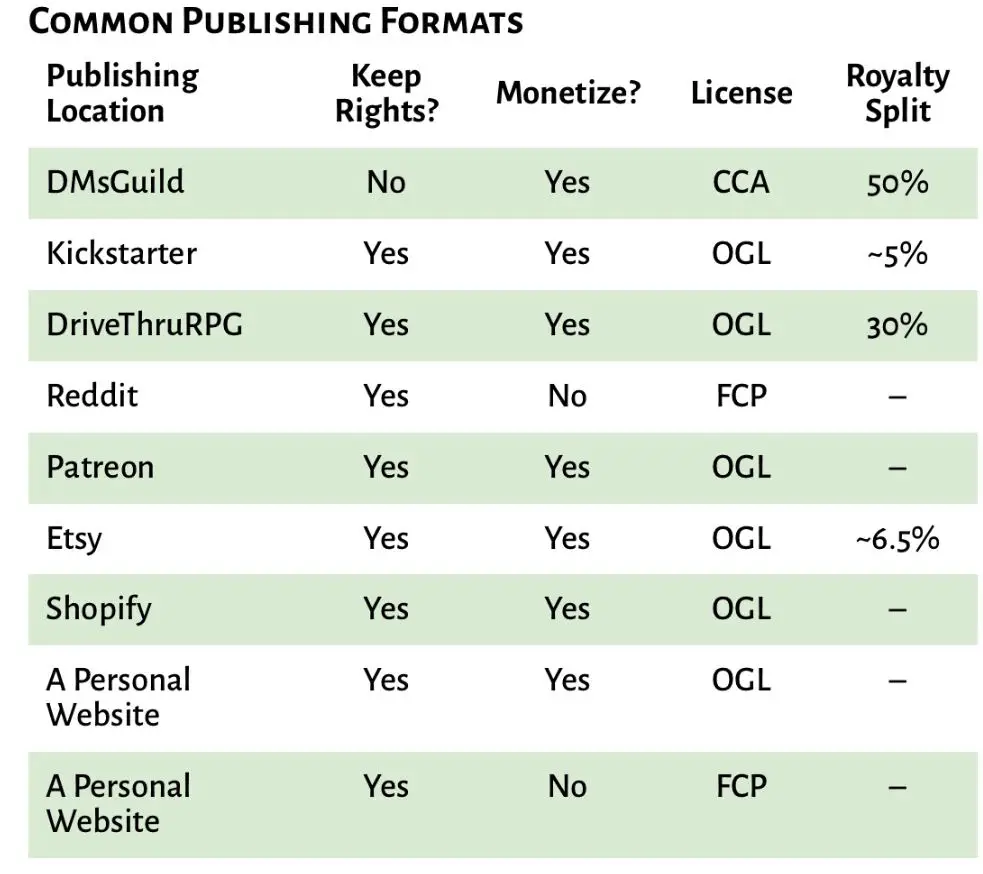
Fan Content Policy (FCP)
Let’s start with the simplest and most generous license in terms of permissions. The Fan Content Policy is one you’ve likely already used if you’ve ever written a piece of content for Dungeons & Dragons and mentioned any of the trademarked properties of Wizards of the Coast in the content. As long as you didn’t charge access to it, you’ve basically already used the Fan Content Policy.
However, if you didn’t use anything that appears within the system to create your work, there’s a chance you may not have used any license whatsoever.
This is the big hang-up for the FCP: you can’t monetize Fan Content Policy work by putting it behind a paywall of any kind. Further, Wizards of the Coast maintains the right to use anything you’ve created using the Fan Content Policy in an official book without even needing to notify you or pay for your work.
Permissions
Can you monetize content using the Fan Content Policy? Yes, with an asterisk. Technically under the Fan Content Policy, you can accept donations for your work through a service like Patreon. However, you can’t restrict access to the content by any means.
While some content creators have been fully monetizing their content with the Fan Content Policy, it is not legal to place said content behind a paywall of any kind. Speaking from experience here, don’t follow the lead of other creators as if they’re acting in compliance. It’s always best to make sure you’re adhering to the licenses to avoid any legal recourse.
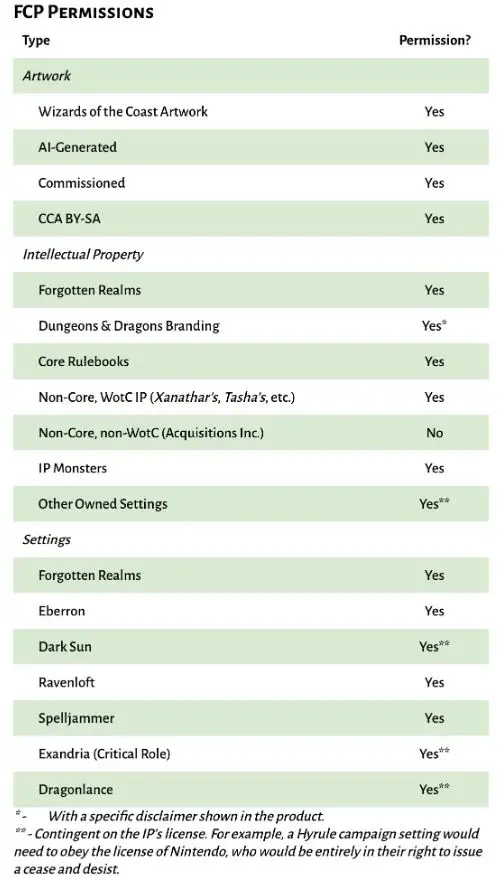
DMsGuild Community Content Agreement (CCA)
This is probably the strongest license in terms of what it allows you to use from official books, though it’s the most restrictive in terms of publishing.
This License is Best For…
- Making content within an official setting.
- Making content that uses work from the official books.
- Publishing content using any Wizards of the Coast owned-IPs.
This License is Not For…
- Publishing your own campaign setting
- Publishing fan content of IPs not owned by Wizards of the Coast
You will be allowed to monetize your work and use more Wizards of the Coast content than you would with the Open Game License. However, you will be splitting royalties on your work with OneBookShelf (30%) and Wizards of the Coast (20%), which means you will only be making 50% of the revenue on anything you create with this license.
Additionally, the DMsGuild does not immediately pay out when you make a sale. You must wait at least 30 days after the sale to withdraw funds. While I understand the DMsGuild has this in place to wait for payments to clear, sites like Shopify offer immediate deposits if customers pay with Paypal and next-day deposits if they pay with a debit or credit card.
Further, and probably most heartbreaking, you release the rights to your work the moment you publish it to the Dungeon Masters Guild. If you later decide you wrote something you would like to print on your own, the DMsGuild would be entirely in their right to issue a cease and desist. This has been overwhelmingly the biggest deterrent for using the CCA I’ve heard from aspiring and professional creators. It’s one of the major reasons I have been moving toward OGL publishing.
Now, this article won’t be me trying to dissuade you from publishing there. The DMsGuild is fine for people establishing themselves as creators and potentially being scouted for work, but you may eventually find yourself feeling undervalued by continuing to publish there, especially once you know what freelance designers are typically paid for design work (~$0.15-$0.25 per word, with royalties). It’s not the kind of thing I would try to set anyone up for with the expectation that you will make a living doing this. The people that are making a living represent an extremely small portion of the DMsGuild community. That’s not to say they don’t exist, but they represent less than 1% of content creators on the platform.
My biggest piece of advice from my time publishing there is to use the DMsGuild as a launching pad to greater heights rather than a foundation to build a house. If your work gets attention, it can lead to potential collaborations that can get you even more work. These days, I use the Guild as a portfolio of my design work which also makes me some side cash rather than the main source of my income, which we can go into further in the next section…
My Perspective
I started taking my homebrew design work more seriously early in 2020. The pandemic led to both my partner and I being let go from our jobs, and we were both drawing unemployment. During this time, I reached out to two designers whose work I admired: Benjamin Huffman and Ross Leiser. I hired both of them to do a serious, thorough critique of my Merchant class that I had originally published in late 2018. The two months of correspondence with them were fundamental in turning me into the designer I am today. After posting the revised Merchant class, I followed it up with the Dancer class and hired heavyarms as a mechanical consultant. The influence of these three people shaped my design sensibilities and led to my earning of multiple accolades in the TTRPG industry.
Even as a successful creator on the DMsGuild, I have consistently pulled in about $600 a month on the DMsGuild for the past 8 months. However, it took me about 2 and a half years of consistent, quality products and successful collaborations to even get there. The products and their industry accolades include:
- The Merchant Class (Platinum)
- The Dancer Class (Gold)
- The Runekeeper Class (Gold)
- The Alchemist Class (Electrum)
- Narrative-Driven Character Creation (Electrum)
- Legends of Frozenfar (Electrum)
- Tasha’s Crucible of Everything Else Vol. 1 (Mithral)
- Tasha’s Crucible of Everything Else Vol. 2 (Platinum)
- Home-Field Advantage (Mithral, Silver ENnie Award)
Even with thousands of sales, I’m making roughly $3.75 an hour for my work. While this is now passive income, and it had major spurts of sales on release days and when major D&D Influencers covered my work, treating publishing on the DMsGuild as a full-time job and barely earning minimum wage will burn you out.
I have seen too many great creators cease tabletop publishing from this burnout after a product doesn’t give them a return on their investment. I’ve heard some creators say publishing on the DMsGuild is a gamble, and I agree to an extent–it’s not slots or roulette; it’s more like poker. People who developed the skills for quality work and researched the market will rise to the top, but doing so can be a serious grind that isn’t for everyone.
Pay What You Want
Even if you sell your product for “Pay What You Want” on the DMsGuild, you will split your royalties. Personally, I don’t believe you should release something for Pay What You Want if you are trying to establish yourself as a creator. They tend to never reach the Most Popular DMsGuild Titles banner, which usually determines a product’s success or failure.
Artwork
Artwork can be tricky to navigate under the CCA. There are a few rules regarding what kind of artwork can be used, and the DMsGuild’s restrictions on artwork have led to a change in rules around what kind of content can be depicted in the art.
As of right now, the best course of action you can take is to assume that if you did not license it, commission it, purchase it, or download it through the DMsGuild Creator Resource packs, you can’t use it in your product. This isn’t universally the case, so I’ll go through some art asset categories I know are confusing.
Public Domain. All public domain artwork is fine to use in DMsGuild work. Just make sure to obey any stipulations the source requests for commercial usage.
Stock Image Sites. These are always on a case-by-case basis, but the vast majority of stock art websites have a clause on commercial rights usage and licensing. I still use Adobe Stock Images as filler and spot art in my products, but their site specifically states that commercial usage is allowed. Always check with the site you sourced the image from.
Wizards of the Coast Artwork. While some assets are allowed for use, the vast majority of the artwork that has appeared in Wizards of the Coast books is not available for most creators. Some writers were given special permissions in the earlier years of the DMsGuild through the Adepts program (for example, M.T. Black was given permission to use Xanathar’s Guide to Everything artwork for the Blue Alley adventure), but this seems to always be on a case-by-case basis. The safe assumption is that you can’t use Wizards of the Coast artwork in your work.
AI-Generated Art. Recently, the rise of AI-Generated artwork led to controversy on some DMsGuild titles. Thus, OneBookShelf implemented a new rule that states you must give a disclaimer if your work contains any AI-Generated artwork. There has also been pushback about selling AI-Generated artwork as stock art because it flooded the storefront. As of right now, this is still allowed on OneBookShelf sites, but this could always change and I would expect it to do so based on the community feedback we’ve seen so far.
CC-BY-SA. Back in 2019, I reached out to the Dungeon Masters Guild for clarification about Creative Commons by Share Alike assets. At the time, I was told by Lysa Penrose that the license was not compatible with the DMsGuild Community Content Agreement due to one of the restrictions being that your work must also be licensed under the CC-BY-SA. I have since heard multiple interpretations of how these licenses may be compatible, and the DMsGuild’s “Logo and Artwork Questions” resource seems to indicate that some Creative Commons licenses are allowed, but that’s all on a case-by-case basis.
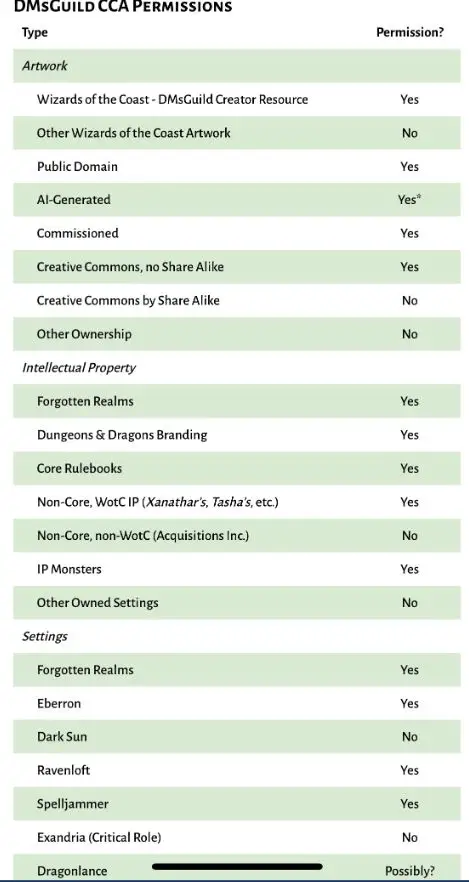
** – Contingent on the IP’s license. For example, a Hyrule campaign setting would need to obey the license of Nintendo.
You also cannot legally redistribute content licensed through the CCA by any means.
Open Game License (OGL)
The Open Game License (also known as the OGL) is the license used by anyone publishing content for the fifth edition system behind a paywall that is not the Dungeon Masters Guild. If you are making money by selling your homebrew content through your own site, you will need to use this license.
Moreover, this is the license used by major publishers that intend to write material that either needs to use the 5e system or a derivative of an earlier edition. Pathfinder still publishes the OGL in each of their books, as the work is built upon the license of an earlier edition.
System Reference Document (SRD)
The OGL allows you to use any part of the game that appears in the System Reference Document (SRD). If you’re considering this path, it’s worth it for you to know briefly what this document contains.
Class Reworks/Class Revisions. Due to how sweeping reworks and revisions typically are, unless the class and its subclasses appear within the SRD, these are nearly always required to be published within the Fan Content Policy or the DMsGuild’s Community Content Agreement. However, if the revised mechanics are distinct enough and you are not using art assets that belong to Wizards of the Coast, there is a chance you may be able to publish it under the OGL.
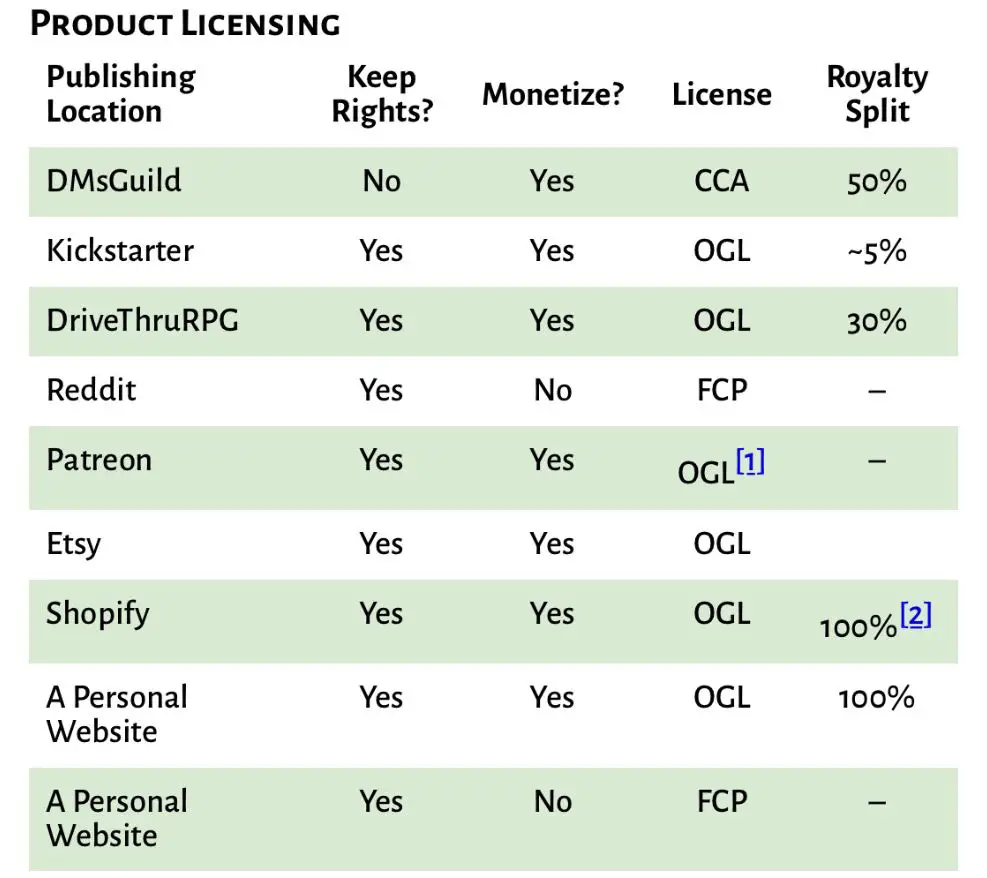
[2] Shopify charges a monthly fee to host your store, and you will need a digital goods app like Downloadable Digital Assets and CollabPay if you intend on splitting any royalties.
Non-Licensed
There is an alternative that avoids any licensing requirements but requires you not to mention the game it applies to in the material and avoid anything within the SRD. This is the most restrictive way to make content for this game regarding what you can use from the D&D intellectual property, but it is the freest in terms of what you can do with the work itself. Works like Sly Flourish’s Return of the Lazy Dungeon Master or Keith Ammann’s The Monsters Know What They’re Doing are examples of works that use this “non-license.”
Thanks
There are a few people I’d like to thank for their help with this article, from fact-checking to vibe-checking. These people are all fantastic creators who I have had the pleasure of working alongside on projects in the past, and you should definitely check out their work as well:
- heavyarms, creator of The Armorer’s Handbook: Equipment Upgrade and Rune Magic System
- Flutes Loot has a review for heavyarms’ Gunslinger class.
- Ross Leiser (Outlandish Adventure Productions), creator of the Accursed, Odic, Shaman, and many other classes, as well as co-creator of Honor and Devotions and Ultimate Adventurer’s Handbook

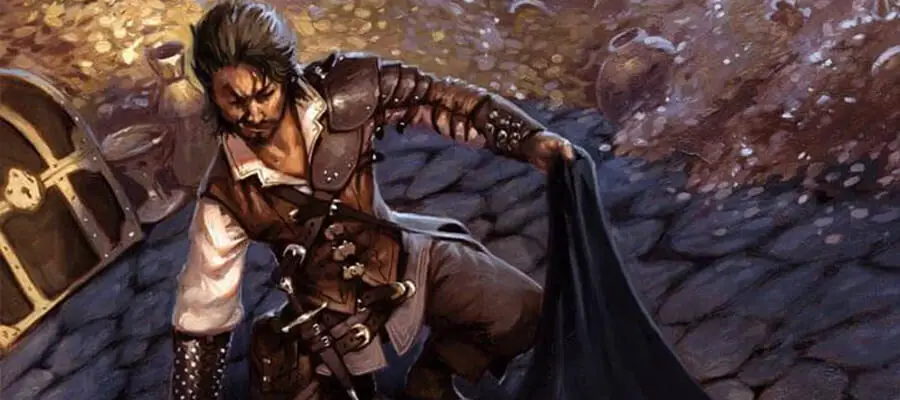


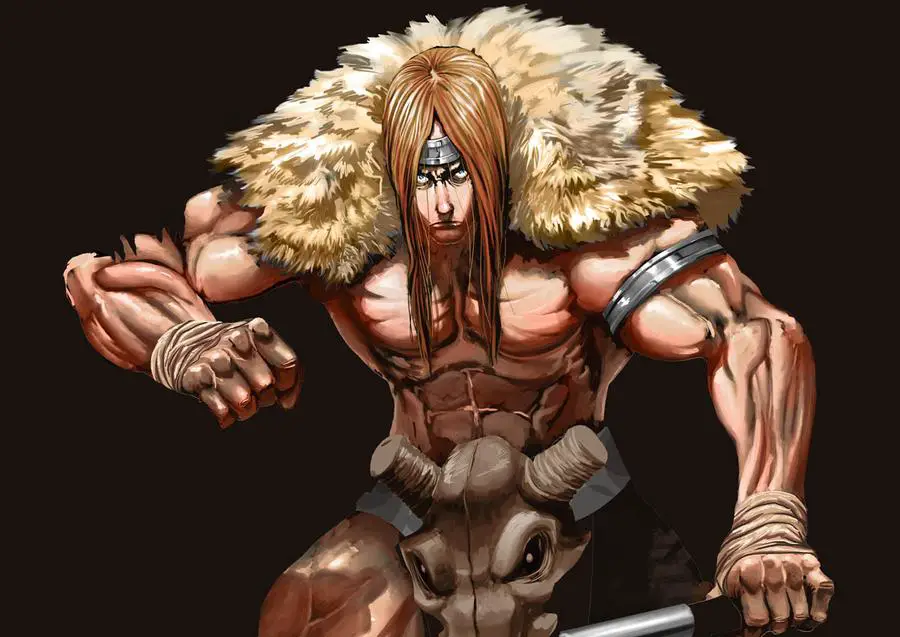
Any plans on an update since the late unpleasantness with the OGL 1.x issues.
We have plans to update this, but it’s tough to provide guidance at this point in the process. I’ve added a disclaimer.
I noticed that there is no mention of the Artificer class in the SRD. Does that mean that you can’t monetize content that uses things from the Artificer Class (like making new subclasses, infusions, magic items, etc.) through the OGL or Creative Commons?
Right, though you can through the DMs Guild. Otherwise, you could get in legal trouble for selling Artificer-specific content without license.
What is the deal with Patreon? Based on the article, it seems like there is some ambiguity. Any idea why that is?
Patreon is actually straightforward. The Patreon content created for D&D needs to use the OGL (now the Creative Commons rules). The author gave room for potential FCP content as it could qualify. It really depends on what the Patreon creator is dishing out as content.
So if I want to to use say, a troll, in a one-shot I’m writing. Do I need to homebrew that troll from scratch? Or can I use the stats from the MM just not the artwork?
The Troll is in the SRD, so you don’t have to homebrew or rename it. You can reference the SRD. I wouldn’t use the artwork.
Can I use the picturesque stat blocks that are on DnD Beyond or out of the book or do I need to retype them when I feel it’s necessary to have the information right in there in the one-shot?
I recommend not taking the stylization directly, but if the text is available in the SRD, you can use it.